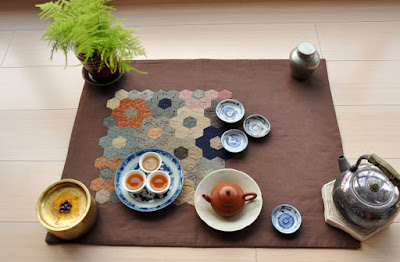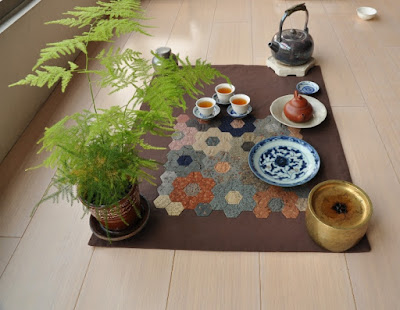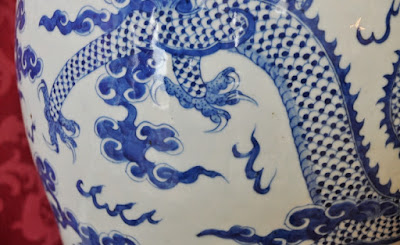Friday, September 25, 2015
The grace of Fall High mountain Oolong
Cultivar: Qingxin Oolong
Harvested by hand on September 5th, 2015
Origin:Qilai mountain
Elevation: 2000 meters
The summer and fall seasons usually produces lower quality fresh Oolong, because the weather is too hot. The leaves grow too quickly, which means few buds, and less fine aromas. However, at higher elevations, the climate conditions are quite similar to spring: the nights are cool and the days short.
I'm glad to brew this excellent example of fine autumn Oolong. The leaves are very well processed and come from a recent plantation on the lesser known Qilai mountain.
The clarity of the brew is excellent. Being very fresh and top quality, it's very easy to mistake these leaves for spring Oolong if you are not told in advance. The difference is subtle.
And the taste is simply wonderful. Sweet and lively. Very fine taste and long aftertaste. Lots of very freshness and lightness with a hint of fall aromas. That's the inspiration for this Chaxi: lightness and purity with hints of fall colors.
This Qilai Oolong and another Fall top qualtiy Oolong from Lushan are available on my boutique!
Have a wonderful Mid Autumn Lunar Festival this weekend!
Thursday, September 24, 2015
Jumping from Da Yu Ling to the moon
The start of the autumn season means it's time to light the charcoal fire in the Nilu again and let its sweet scents mingle with the fragrances of the mountain. But before going any further, let me dedicate this article to Christopher. I had invited him to join this San Hsia fall Chaxi, but he didn't feel well that morning and had to cancel. His misfortune reminds me how fragile and fleeting tea, life, happiness can be. This is one more reason to cherish these moments when we have the chance of getting everything right: the location, the equipment, the tea and friends from distant places.
And that's why I'm writing a second post about this fall Chaxi with Pat, the Tea Institute alumni from Penn State and Samantha from Canada. After the Baozhong, we brewed the winter 2014 Da Yu Ling High mountain Oolong. We had to patiently wait for the water to come to a boil.
Here is Sam's first time with a silver kettle and zhuni teapot!
I instruct her to pour some water on the teapot on the full teapot in order to increase the temperature a notch and get even more flavors out of these excellent leaves.
I always feel there's something playful and almost naughty in pouring water on a teapot. It's literally a way to blow off some steam!
There's a range of emotions that happen during a tea preparation. Handling the energy of the boiling water from the kettle to the teapot. Calming down during the actual brewing. Focusing on the pouring in the cups with grace.
Being quiet and attentive as a guest helps the brewer pour more accurately.
Sam has nicely balanced the tea between the 3 cups.
The color and clarity of the brew are the first indicator of its success.
Then comes the scent coming from the cup.
And when it's good, the highest pleasure comes from sharing it.
Dayuling transports us to a cooler, windy place. Its freshness in the mouth is almost like mint. It coats the palate and creates a buzz, a fizz feeling like very small Champagne bubbles. This energy tickles, comes and goes like waves that are building and then disappear as they have reached the shores. The scents are very fine, fresh and evanescent. The mellow taste endures and resonates in the body for several minutes.
A special tea for a special occasion.
And with the Mid autumn Lunar Festival approaching, we're also enjoying some moon cakes between our tea tastings.
And speaking of moon cakes, here are latest commercial news from my online tea boutique:
- to celebrate the Mid Autumn Lunar festival, I'm discounting 12 teas until end of September only. Among them are many Hung Shui Oolongs and an aged loose puerh that are good fit with the cooler Fall season.
- the 25 grams gift for orders over 60 USD is now Jinxuan Oolong from Zhushan.
And that's why I'm writing a second post about this fall Chaxi with Pat, the Tea Institute alumni from Penn State and Samantha from Canada. After the Baozhong, we brewed the winter 2014 Da Yu Ling High mountain Oolong. We had to patiently wait for the water to come to a boil.
Here is Sam's first time with a silver kettle and zhuni teapot!
I instruct her to pour some water on the teapot on the full teapot in order to increase the temperature a notch and get even more flavors out of these excellent leaves.
I always feel there's something playful and almost naughty in pouring water on a teapot. It's literally a way to blow off some steam!
There's a range of emotions that happen during a tea preparation. Handling the energy of the boiling water from the kettle to the teapot. Calming down during the actual brewing. Focusing on the pouring in the cups with grace.
Being quiet and attentive as a guest helps the brewer pour more accurately.
Sam has nicely balanced the tea between the 3 cups.
The color and clarity of the brew are the first indicator of its success.
Then comes the scent coming from the cup.
And when it's good, the highest pleasure comes from sharing it.
Dayuling transports us to a cooler, windy place. Its freshness in the mouth is almost like mint. It coats the palate and creates a buzz, a fizz feeling like very small Champagne bubbles. This energy tickles, comes and goes like waves that are building and then disappear as they have reached the shores. The scents are very fine, fresh and evanescent. The mellow taste endures and resonates in the body for several minutes.
A special tea for a special occasion.
And with the Mid autumn Lunar Festival approaching, we're also enjoying some moon cakes between our tea tastings.
And speaking of moon cakes, here are latest commercial news from my online tea boutique:
- to celebrate the Mid Autumn Lunar festival, I'm discounting 12 teas until end of September only. Among them are many Hung Shui Oolongs and an aged loose puerh that are good fit with the cooler Fall season.
- the 25 grams gift for orders over 60 USD is now Jinxuan Oolong from Zhushan.
Wednesday, September 23, 2015
Douceur d'automne du Wenshan Baozhong
 |
| Wenshan Baozhong 'forêt subtropicale' |
"Le thé, chacun en fait ce qu'il veut' me disait un lecteur/visiteur hier soir. Et c'est vrai que la façon dont on infuse le thé est aussi un reflet de sa personnalité, de son exigence de raffinement et de goût. Et si le thé est très flexible et donnera de ses arômes dans toutes les circonstances (à froid, en sachet, en porcelaine, à l'indienne, avec ou sans sucre...) il n'en reste pas moins que certaines personnes et méthodes obtiennent un meilleur résultats que d'autres.
Patrick, membre fondateur du Tea Institute de Penn State University a eu l'occasion de préparer la seconde infusion de mon Baozhong. Ses gestes sont précis et pleins d'attention. Il est heureux de retrouver l'occasion de pratiquer un Chaxi traditionnels avec de l'eau chauffée au charbon de bois.
Ce gaiwan bigarré aux motifs de dragons et phoenix est en accord parfait avec la toiture de ce temple local où l'on retrouve ces mêmes animaux hauts en couleurs!
Patrick réussit aussi très bien à verser le thé dans les coupes sans en mettre à côté. Ses années de pratique et d'apprentissage se voient et font plaisir à voir. Son intense bonheur de revenir à Taiwan se ressent dans sa coupe.
Mais ce bonheur est sûrement aussi du à la présence de la charmante Sam qui l'accompagne! Pour elle, c'est la toute première fois qu'elle infuse avec un gaiwan!
Et elle s'en sort pas mal du tout! Sa joie est mêlée d'appréhension et d'enthousiasme. Son infusion a beaucoup de douceur. Elle est tellement en phase avec les odeurs de fleurs subtropicales qui émanent de la forêt toute proche! On a là un exemple intéressant de maturation du Baozhong, thé plus fragile que le Oolong car ses feuilles torsadées sont plus en contact avec l'air. Comme tout produit vivant, il continue à évoluer et sa qualité se remarque au fait qu'il devienne plus doux et fin et non pas amer ou acide (comme cela peut être le cas pour un thé insuffisamment séché au départ).
D'ailleurs, ce Baozhong a vu son prix baissé de 20%. Et pour célébrer la nouvelle saison qui commence, j'ai réduit le prix de 12 thés de plus jusqu'à la fin septembre seulement. J'ai aussi mis les photos de la page d'accueil de la boutique Tea-masters aux couleurs de l'automne.
Friday, September 18, 2015
Preheating advice
Preheating is a key element of successful brewing.
Not only should you always preheat your teapot, but there's even a trick that will prevent your teapot from suffering a thermal shock. Start by pouring the off the boil water on the lid of the closed teapot (see above). This safely increases the temperature of the teapot. Then, in a second step, remove the lid and pour the water in the teapot. Be especially cautious to do so in a cold room or with an older teapot that hasn't been used for a while.
Note: you'll find many more tricks in my Oolong Brewing Guide.
Not only should you always preheat your teapot, but there's even a trick that will prevent your teapot from suffering a thermal shock. Start by pouring the off the boil water on the lid of the closed teapot (see above). This safely increases the temperature of the teapot. Then, in a second step, remove the lid and pour the water in the teapot. Be especially cautious to do so in a cold room or with an older teapot that hasn't been used for a while.
Note: you'll find many more tricks in my Oolong Brewing Guide.
Thursday, September 17, 2015
Beauté orientale
 |
| Beauté Orientale de 2013 |
Il n'est (malheureusement) pas possible de trancher cette question par un oui ou non. Cela serait trop facile, et le thé n'est pas un sujet simple. Cela dépend du degré de l'oxydation et de torréfaction des feuilles. Derrière la même appelation, le même nom, on peut trouver une grande variations de styles et de process. Cela varie en fonction des goûts des clients, de la qualité des feuilles, de la mode du moment... Ainsi, les OB de compétition ont tendance à être très légers: des bourgeons jeunes et nombreux, assez faiblement oxydés et séchés. Il s'agit d'obtenir des parfums très frais et fins. Ceux-là, il vaut mieux les boire jeunes.
Les bourgeons sont plus fragiles que des grandes feuilles, surtout si leur oxydation est légère. La torréfaction y est une opération plus risquée, mais elle est primordiale, car les bourgeons contiennent le plus d'humidité et risquent donc d'oxyder (et de donner des saveurs acides) avec le temps si ils ne sont pas suffisamment secs.
La torréfaction est un savoir-faire. Au départ, cela enlève de la fraicheur aux arômes et rend goût un peu fermé. Mais cela permet au thé de s'épanouir avec le temps.
Pour tester ce qui pourrait n'être qu'une théorie, j'ai fait une nouvelle dégustation de mon OB de 2013, un très bon exemple d'une version traditionnelle de cet Oolong. Pour mieux apprécier sa finesse, j'ai un peu diminué la quantité des feuilles. Ouvertes, elles ne remplissent pas entièrement le gaiwan et je n'ai pas fait d'infusions trop longues.
Le résultat me convient entièrement. Je note que les fragrances dues à l'âge se manifestent plus rapidement que chez un Hung Shui Oolong. Finesse et puissance. Douceur et chaleur.
Un excellent thé pour l'automne...
Tuesday, September 15, 2015
1990 Hung Shui Oolong from San Hsia
I purchased this tea in early 2009, almost 7 years ago. Its aromas of wild, ripe raspberries were amazing and so was its energy and rock taste. This is what properly aged Hung Shui Oolong can turn into AND it doesn't require any re-roasting. All you need is patience, time and the great Hung Shui Oolong. And not only would you obtain something great after 19 years (in 2009), but it would continue to improve!
Today, I found that I still have a pack with 100 grams of this tea! It hasn't been re-roasted and I simply left it in its vacuum-sealed plastic foil (because I hadn't a fitting porcelain jar for it).
So, this gave me the opportunity to test the proposition that it's still improving with time,
The fragrances are still very similar. Keeping it vacuum-sealed is slowing the changes. However, the taste felt deeper and more powerful than before. Or maybe it's also my brewing that is getting better? But I still feel I obtained a more concentrated first brew than in the past. The taste and aftertaste were amazing for their mix of aged, mellow depth and fresh energy.
Top grade Oolongs are those who improve with age. And here age is measured in years or even decades! This is one of the things that makes Oolong so fascinating.
I am glad to make this San Hsia Hung Shui Oolong available again and let you taste for yourself how it has evolved.
The qinghua plate can be used as teaboat for the teapot or as chadian for the cups, when they are gathered for the pour. This protects the chabu from getting tea stains.
The mini plate have also 2 uses: as chahe to display the dry leaves before brewing, or as cha tuo (saucer) for 1 cup. Actually, you can also use them as a resting place for the cover of the teapot when you take it off before filling your teapot with boiled water.
Monday, September 14, 2015
Marignan 1515 et la Renaissance en France
 |
| Château de Chambord |
 |
| François 1er |
 |
| Jarre qinghua au motif de dragon du château de Chambord |
La Renaissance coincide avec la dynastie des Ming. C'est l'âge d'or de la porcelaine chinoise! Aussi, il n'est pas étonnant que les monarques européens s'entichent de cet 'or blanc' et qu'on trouve de très belles pièces dans les musées et châteaux de toute l'Europe. Sur cet agrandissement, on voit bien que le bleu n'est pas uniforme, mais qu'il existe plusieurs niveaux de dégradé qui donne mouvement et force à ce dragon.
 |
| Vue de Chambord |
C'est le thé qui me permit de rencontrer la troupe de Doulce Mémoire, un ensemble de musique de la Renaissance de Tours, venu jouer à Taipei, devant le Musée du Palais National. Je vous recommande tout particulièrement leur dernier album, intitulé, fort à propos, "François 1er, musiques d'un règne"!
Dans le même registre, si vous aimez, je vous recommande aussi Huelgas Ensemble (La Oreja de Zubaran), Capella de Ministrers (Planctus), Vox Luminis, Gli Incogniti, Jordi Savall...
 |
| Château d'Amboise |
Subscribe to:
Comments (Atom)





















































